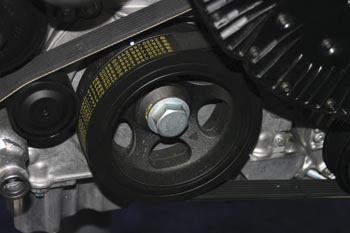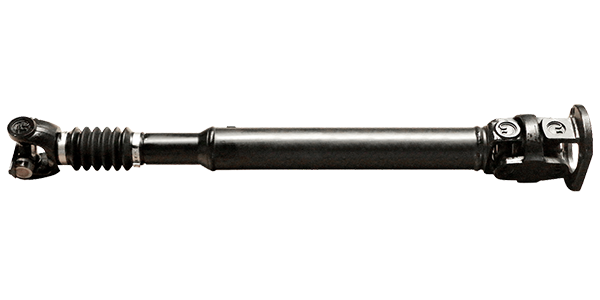Many engines today have two or more belts that will need to be replaced at some point. One is the timing belt, if the engine has an overhead cam design and uses a belt rather than a chain to drive the cam(s). The other is one or more serpentine belts on the front of the engine that drive the engine’s accessories, such as the alternator, power steering pump and A/C compressor.
 The replacement interval for timing belts is longer than it used to be, with many late-model vehicles now specifying a recommended replacement interval of 100,000 to 120,000 miles. For older vehicles (those built prior to 1997), the recommended replacement interval is usually 60,000 miles. The best bet is to always defer to the OE replacement recommendations.
The replacement interval for timing belts is longer than it used to be, with many late-model vehicles now specifying a recommended replacement interval of 100,000 to 120,000 miles. For older vehicles (those built prior to 1997), the recommended replacement interval is usually 60,000 miles. The best bet is to always defer to the OE replacement recommendations.
Belt replacement is recommended to prevent belt failure. It’s as simple as that. As the belt ages, it weakens. The rubber on the outside of the belt can harden and crack. The reinforcing cords inside the belt, which provide tensile strength and prevent the belt from stretching, also lose strength. In some cases, the laminated layers of the belt may begin to separate.
Timing belt failure is serious business. If an OHC (overhead camshaft) timing belt fails, one of two things can happen. If the engine has sufficient clearance between the valves and pistons, a belt failure will cause the engine to stop running, but won’t harm the engine. Such is not the case in engines with tight clearances between the valves and pistons. A belt failure in an “interference” engine will allow the pistons to strike one or more valves. This usually bends the valves and causes expensive engine damage. These kind of problems can be avoided by replacing timing belts at the recommended intervals. On most vehicles, this is a once-in-a-lifetime job. But on unusually high mileage vehicles, it may be repeated more than once.
There is usually no noise or other symptoms to warn a motorist that a timing belt is on the verge of failure. One minute the engine is running fine and the next it is as dead as a dodo bird.
Of course, technicians can inspect timing belts for clues that indicate the belt needs to be replaced. This includes obvious damage such as frayed or exposed cords, damaged teeth, hunks of rubber missing, deep age cracks, excessive surface cracking or severe glazing. Any belt with these symptoms should be replaced without delay.
If a belt has stripped cogs, something in the cam drive system has jammed or stuck, overloading the belt and causing it to shear teeth or jump time. The most likely culprit is the camshaft, which may have seized due to engine overheating or lack of lubrication (low oil level or loss of oil pressure).
When a timing belt is replaced, it’s a good idea to take a total “systems approach” and replace all the necessary components. By replacing the belt and the tensioners, you are really returning the timing system to like-new condition. It’s also a good idea to replace the idler pulley and water pump at the same time too.
Although tensioner and idler pulley bearings are sealed for life, that doesn’t mean they last forever. The bearings wear out, loosen up and may become noisy. If a tensioner or idler pulley is loose or has grease streaks radiating outward from the bearing, it needs to be replaced. Stocking timing component kits are a good way distributors can keep SKU counts at a manageable level.
Replacement timing belts must be identical to the original, with the same length, width, tooth profile and pitch. The replacement belts should also be the same type as the original. Do not substitute a less expensive neoprene belt for one made of HSN (Highly Saturated Nitrile). Some no-name brands use inferior materials that won’t last as long as the OEM belt or a quality aftermarket belt.
It’s pretty much the same story with serpentine belts. After 50,000 or 60,000 miles, the original belt may be showing some age cracking, fraying and/or glazing. But on many 2003-and-newer vehicles, serpentine belts are made of EPDM (Ethylene Propylene Diene Monomer), a high temperature synthetic material that can last up to 100,000 miles or more. Even so, serpentine belts don’t last forever. Dirt and debris that lodges in pulley grooves can accelerate belt wear and may even cause a belt to slip. Slippage is bad because it generates heat and ages the belt even faster.
Like timing belts, it’s wise to replace serpentine belts before they fail. On many vehicles, one belt runs everything — so a belt failure means loss of engine cooling, battery charging, power steering and air conditioning. In short, a belt failure means a breakdown.
The first sign of a belt failure may be a charging system or low voltage warning light, followed shortly by an engine temperature warning light (the engine will quickly overheat if the belt fails). The steering will also feel noticeably stiffer as soon as power assist is lost, and there will be no cooling output from the A/C system.
In some cases, noise and/or glazing is due to a bad automatic belt tensioner. The spring inside an automatic tensioner can weaken with age, and the pulley bearings can become worn and loose. Rust and corrosion can also jam a tensioner so it can’t maintain proper tension on the belt. That’s why the tensioner should be inspected or replaced when the belt is changed. A new tensioner will restore like-new operation and reduce the risk of future problems and comebacks.
Make sure the length of the replacement belt is the same as the original. Most automatic tensioners have a very limited range of travel, so a difference in belt length of only a few fractions of an inch may cause trouble.











